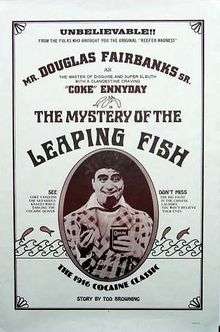The Mystery of the Leaping Fish
| The Mystery of the Leaping Fish | |
|---|---|
 Reissue theatrical poster | |
| Directed by | |
| Written by | Anita Loos (intertitles) |
| Story by | Tod Browning |
| Starring | |
| Cinematography | John W. Leezer |
| Distributed by | Triangle Film Corporation |
Release dates |
|
Running time | 25 minutes |
| Country | United States |
| Language |
|
The Mystery of the Leaping Fish is a 1916 American short silent comedy film starring Douglas Fairbanks, Bessie Love, and Alma Rubens. Directed by John Emerson, the story was written by Tod Browning with intertitles by Anita Loos.[1][2]
A 35 mm print of the film still exists in its entirety and is currently in the public domain.[3]
Overview
In this unusually broad comedy for Fairbanks, the acrobatic leading man plays "Coke Ennyday", a cocaine-shooting detective who is a parody of Sherlock Holmes. Ennyday is given to injecting himself from a bandolier of syringes worn across his chest, and liberally helps himself to the contents of a hatbox-sized round container of white powder labeled "COCAINE" on his desk.[1]
.webm.jpg)
Fairbanks's character otherwise lampoons Sherlock Holmes with checkered detective hat, clothes and even car, along with the aforementioned propensity for injecting cocaine whenever he feels momentarily down, then laughing with delight. A device used for observing visitors, which is referred to in the title cards as his "scientific periscope", bears a close resemblance to a modern closed-circuit television. What is apparently a clock face has "EATS, DRINKS, SLEEPS, and DOPE" instead of numbers.[4]
The film displays a lighthearted and comic attitude toward Coke Ennyday's use of cocaine and laudanum. While he catches a gang of drug smugglers, he does so after consuming most of their opium.[5]
Cast
- Douglas Fairbanks as Coke Ennyday
- Bessie Love as the little fish blower
- Alma Rubens as his female accomplice
- Allan Sears as Gent Rolling in Wealth (Credited as A.D. Sears)
- Charles Stevens as Japanese Accomplice
- Tom Wilson as Police Chief I.M. Keene
- George Hall as Japanese accomplice (uncredited)
- William Lowery as gang leader (uncredited)
- Joe Murphy as footman on vehicle (uncredited)
- B.F. Zeidman as scenario editor (uncredited)
Themes
The Mystery of the Leaping Fish was released in 1916, one year before the Harrison Act was enacted. Narcotic prohibition was still a new concept in the United States, and the use of opiates and cocaine was much more socially acceptable than today. Furthermore, the censorious Hays Code would not be instituted for another fourteen years after the film's release. With the introduction of the code, depictions of intravenous drug use were not shown in major motion pictures. During the era of the Hays Code, films that dealt with controversial topics such as drug use were morality plays that illustrate the degradation that surrounds the use of such drugs.[6]
Production
Running a total of 25 minutes, the film was initially shot by Christy Cabanne who was later fired from the production.[7][8] John Emerson was hired and re-shot the film with the help of Tod Browning.[8]
When filming in Chinatown, the production was attacked by members of the community, because they had not requested to film in the neighborhood.[9]
Reception
The film was a departure for Fairbanks due to the subject matter and the fact that he generally appeared in feature films, not two-reelers. The Mystery of the Leaping Fish was the second film Fairbanks did with director John Emerson, their first being His Picture in the Papers (released in February 1916) which was a hit.[10]
While The Mystery of the Leaping Fish is now considered something of a cult film due its comedic dealings of drug use,[11][12] Fairbanks hated the film and reportedly wanted to have it withdrawn from circulation.[8] Fairbanks biographer Jeffrey Vance describes The Mystery of the Leaping Fish as "undoubtedly the most bizarre film Fairbanks made" and that the entire scenario is "a hallucinogenic odyssey into the absurd...."[13]
References
- Notes
- 1 2 Basinger, Jeanine (2000). Silent Stars. Wesleyan University Press. p. 108. ISBN 0-819-56451-6.
- ↑ Cherchi Usai, Paolo; Bowser, Eileen (2005). Cherchi Usai, Paolo, ed. The Griffith Project: Volume 9: Films Produced in 1916–1918. British Film Institute. p. 103. ISBN 1-844-57097-5.
- ↑ The Mystery of the Leaping Fish at silentera.com
- ↑ Boy, Susan C. Hooked: Drug War Films in Britain, Canada, and the United States. p. 34.
- ↑ Deflem, Mathieu, ed. (2010). Popular Culture, Crime and Social Control. Emerald Group Publishing. p. 7. ISBN 1-849-50733-3.
- ↑ Stevenson, Jack (2000). Addicted: The Myth and Menace of Drugs in Film. Creation Books. ISBN 1-84068-023-7.
- ↑ Soister, John T. (2012). American Silent Horror, Science Fiction and Fantasy Feature Films, 1913–1929. McFarland. p. 159. ISBN 0-786-48790-9.
- 1 2 3 Vance 2008, p. 36
- ↑ Love, Bessie (1977). From Hollywood with Love: An Autobiography of Bessie Love. London: Elm Tree Books. pp. 59–60. OCLC 734075937.
- ↑ Eagan, Daniel (2010). America's Film Legacy: The Authoritative Guide to the Landmark Movies in the National Film Registry. Continuum International Publishing Group. p. 61. ISBN 0-826-42977-7.
- ↑ Vance 2008, p. 35
- ↑ Lombardi, Frederic (2013). Allan Dwan and the Rise and Decline of the Hollywood Studios. McFarland. p. 63. ISBN 0-786-43485-6.
- ↑ Vance 2008, pp. 35–36
- Bibliography
- Vance, Jeffrey (2008). Cushman, Robert, ed. Douglas Fairbanks. University of California Press. ISBN 0-520-25667-0.
External links
| Wikimedia Commons has media related to The Mystery of the Leaping Fish. |
- The Mystery of the Leaping Fish on YouTube
- The Mystery of the Leaping Fish at the Internet Movie Database
- The Mystery of the Leaping Fish at AllMovie
- The Mystery of the Leaping Fish is available for free download at the Internet Archive